In this guest blog, Afsar Shah, B.A., LLB, Business and Regulatory Coach with The Personal Coach shares his thoughts on the current state of transition planning, some key takeaways and suggested next steps for financial advisors.
We remain mired in the Covid-19 pandemic.
Amidst one of the worst public health crises and economic downturns in recent memory, financial advisor’s have continued to help ensure the financial well-being of their clients. As the crisis continues, however, a growing number of advisor’s are starting to turn attention to their own situation and the longer-term impact of Covid-19 on their business. They are beginning to ask the following questions:
- What is my plan if am no longer able to service my clients?
- How might this crisis affect my own retirement?
- I was planning to sell my business in the next 3-5 years. Does that timing still make sense?
- How has this crisis affected the value of my business? What can I do to increase its value?
- Do I have the motivation and desire to continue working as an advisor post Covid-19?
One of the most significant strategic challenges facing our industry prior to Covid-19 was the lack of advisor preparedness concerning Succession, Continuity and Exit Planning. We all know the stats. Only a small percentage (approx. 10%) of advisors have a written plan for their succession, and the vast majority of advisor’s were not even ‘thinking about’ the eventual transition of their business. In the era of Covid-19, however, this appears to be changing. A growing number of financial advisor’s are realizing the importance of having a robust and well-documented Succession or Transition Plan in place.
This is a positive development. After all, the reality is that every advisor will one day transition out of their business and eventually exit the industry. The only question being on what terms and conditions. It seems obvious that not having a plan in place for an event that is certain to take place makes no sense whatsoever. A robust and well-documented plan is in the best interest of not only advisors but also their clients, family members and staff.
What can we do to help financial advisor’s take effective action and ensure their readiness?
In a series of articles over the next several months, we intend to explore the subject of Succession, Continuity and Exit Planning and the related trends and challenges facing advisors in 2020 and beyond. Our objective is to offer insights and practical tips and suggestions on concepts and strategies, including case studies from The Personal Coach, to help advisors take action and effectively shape the future of their firms.
One of the most frequently asked questions I get from advisor’s who are keen to develop a Transition Plan is - ‘Where do I start?’
What I often suggest is that they start by adopting a different way of thinking about the concept of Transition Planning. And that starts with a clear understanding of the terms Succession Planning, Continuity Planning and Exit Planning and how these concepts ought to work together to create a robust Transition Plan. By doing so, advisor’s will create for themselves a sense of direction, an understanding of the options available to them, and a clearer path forward.
Just about every advisor I know uses these terms interchangeably. In fact, they mean very different things.
Succession Planning – refers to the plan that ensures the seamless and gradual transfer of ownership, leadership and management of an advisor’s business internally to a new generation of advisor’s.
- The key point is that the founding advisors business will endure beyond the life and career of the advisor….and no longer has to rely primarily upon that advisor.
Exit Planning – refers to the plan that ensures the transfer of ownership, leadership and management of an advisor’s business to an external third party.
- This transfer is typically a 100% transfer of ownership and means that the founding advisor’s business does not endure beyond his or her own career.
Contingency Planning – refers to the plan that ensures the seamless transfer of ownership, leadership or management of the advisor’s business in the event of a random and unplanned event – death or disability being the most common, but pandemic as well.
One plan is neither better nor worse than the other. They are just different.
- A Succession Plan at its core is about growing an advisors business by including another generation of advisor’s and leveraging their skills, talent and energy;
- An Exit Plan, on the other hand, is about monetizing an advisor’s business and bringing their practice to a close and career to an end;
- A Contingency Plan is about insuring an advisor’s business and preserving its value in the event of a major unplanned and negative event.
Conventional wisdom would suggest that an advisor must choose at some point in their career between an internal succession plan and an external sale to a third party. This kind of thinking is misguided. A smarter and more effective approach is for an advisor to develop a more comprehensive plan that incorporates all three of the plans described above. Ideally, it should always start with an internal Succession Plan and include a Contingency Plan. In this way, if the internal Succession Plan does not work to the advisor’s satisfaction, an external sale to a third party becomes their fallback strategy.
The term Transition Plan, therefore, refers to the advisor’s plan or strategy that incorporates their respective Succession, Contingency and Exit Plans and outlines the process of changing the advisor’s role as owner, leader and manager of his or her business over time to ‘something else’. That ‘something else’ can be whatever the advisor wants it to be aligned with their long-term goals, objective and vision for their life and business.
The Bottom Line - what are some of the key insights that advisor’s should take away from this?
- Every advisor will one day leave their business and exit the industry. Not having a plan in place makes no sense and is a breach of your duty to clients, family members and staff;
- Start by adopting a different mindset and approach to Transition Planning. Understand the differences between Succession, Exit and Continuity Planning and how they work together;
- Every advisor, irrespective of age and stage of career, needs to have a Continuity Plan;
- It is never too early to begin Transition Planning. Every advisor between the ages of 35-50 ought to be developing a Succession Plan;
- Every advisor over the age of 60 ought to be developing their Exit Plan.
Suggested Next Steps – what can advisor’s do to get going and enhance their preparedness?
- Get Educated – read up on this topic and talk to one of our coaches to learn more;
- Get Started – email The Personal Coach to receive a preliminary Self-Assessment;
- Get Help – call or email Afsar Shah to schedule a Complimentary Consultation.
About the Author
Afsar Shah has been a Business Coach with The Personal Coach since 2018. He has over 25 years’ experience as a senior executive in the financial services industry. Afsar is a corporate lawyer but has spent the vast majority of his career in various roles, including strategy development, mergers and acquisitions, and advisor training and regulatory education.




